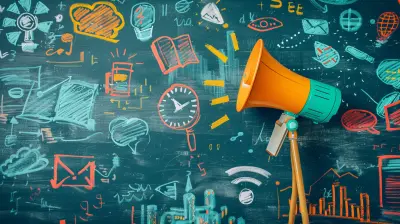How STEM Education Can Help Solve Global Health Challenges
25 July 2025
Let’s get real for a second. Global health is a hot mess in some parts of the world. From pandemics that don’t respect borders to rising antibiotic resistance, and from clean water shortages to mental health crises, we’re up against some seriously stubborn problems. But here’s the juicy part—STEM (Science, Technology, Engineering, and Mathematics) education might just be the dynamic superhero squad we’ve been waiting for.
So, why is STEM education the Beyoncé of solving global health issues? Buckle up, because we’re diving into exactly how nerdy know-how and geeky genius can turn health crises around, one code, calculation, and chemical reaction at a time.
🌍 What’s the Big Deal About Global Health Challenges?
Before we unleash the magic of STEM, let’s have a quick heart-to-heart about what we’re dealing with here. Global health challenges aren’t just about exotic viruses in far-off lands (though, yeah, those too). They’re:- Preventable diseases still causing millions of deaths
- Unequal access to healthcare (why does your zip code still decide your life expectancy?)
- Mental health stigma—yep, still a thing
- Clean water and sanitation issues
- Chronic diseases like diabetes and heart disease spreading globally
- Antibiotic-resistant superbugs (they sound like comic-book villains, but they’re very real)
And the twist? Most of these are FIXABLE—or at least manageable—with the right tools, knowledge, and innovation.
💡 Enter STEM: The Sassy Game-Changer
So here’s where STEM education struts in like it owns the place. It's not just about memorizing periodic tables or solving calculus equations while sobbing into your textbook (although, #relatable). STEM is about critical thinking, creativity, innovation—and yep, saving lives.Let’s break down how STEM education is already making seismic waves in global health and why it holds the key to future breakthroughs.
🧬 Science: The Brains Behind the Breakthroughs
Science is basically the Sherlock Holmes of global health. It's the reason we have vaccines, diagnostic tests, and treatments that actually work. Give young minds the tools of science through strong STEM education, and suddenly we’ve got a new wave of disease detectives.🦠 Fighting Diseases, One Petri Dish at a Time
From understanding how viruses mutate to creating vaccines at warp speed (cough COVID-19, anyone?), science gets to the root of the problem. A curious 14-year-old learning about DNA sequencing today? That’s tomorrow’s Nobel Prize-winning virologist.🧪 Research = Results
STEM education teaches how to ask questions, form hypotheses, and test ideas—the exact process that leads scientists to medical breakthroughs. It's like giving the next generation a treasure map to find answers to the most puzzling health issues.
🤖 Technology: The Digital Doctor Is In
Let’s talk tech, shall we? From AI-driven diagnostics to telemedicine apps, technology is revolutionizing healthcare faster than you can say “robot surgeon.” And guess where that starts?Yep—STEM classrooms.
🩺 Telemedicine = Health Without Borders
STEM-powered tech is closing the gap for rural areas and underserved communities. Can’t reach a hospital? No problem, just Zoom your doc. A student who learns to code today could build tomorrow’s life-saving health tech.📱 Apps That Could Save Your Life
Got a smartwatch or fitness tracker? That’s tech working quietly in the background—monitoring heart rates, sleep cycles, and even blood oxygen levels. Mobile health (mHealth) apps are being developed by STEM-savvy minds to manage everything from diabetes to depression.🏗️ Engineering: The Architects of Accessibility
Engineering isn’t just about bridges and blueprints—it’s about building solutions that stick. When it comes to healthcare infrastructure, engineers are the unsung heroes making health solutions happen.🚰 Clean Water is a Game-Changer
No clean water? No public health. Period. Engineers design water filtration systems that prevent disease and improve sanitation in resource-limited areas. That’s not just cool—it’s life-saving.🏥 Medical Devices That Go the Distance
Imagine a solar-powered incubator for premature babies in rural clinics. Or low-cost prosthetics made from recycled materials. These innovations come from the minds of STEM-trained engineers who think outside the box and care deeply about access.📊 Math: The Silent Powerhouse
Math might not get the spotlight, but don’t sleep on it—it’s the brains behind the scenes analyzing, predicting, and preventing health disasters.📉 Predicting Outbreaks Before They Explode
Epidemiologists rely on math to track how diseases spread, using models that literally save lives. Think of math like a crystal ball you can trust.💰 Efficient Resource Management
Math helps public health workers plan how to distribute vaccines or allocate hospital beds during crises. It's like having a logistical GPS to navigate through chaos.🎓 STEM Education = Empowerment
Alright, now you might be asking: “Why not just hire smart doctors and scientists instead of focusing on STEM education?”Here’s the thing—STEM education creates a ripple effect. It empowers individuals, communities, and entire nations to participate in their own health futures. It transforms passive sufferers into proactive solvers.
🌱 Homegrown Solutions
When kids in Kenya learn to code or Colombian teens tackle chemistry, they’re creating solutions tailored to their own communities. Forget foreign aid—this is grassroots genius in action.💼 Careers That Change the World
STEM education opens the door for young people to step into careers where they can actually make a difference. Whether it’s biotech, health analytics, or biomedical engineering, these fields are hungry for fresh, diverse voices.💪 Representation Matters
Let’s not ignore the obvious: representation in STEM is still lacking. More girls, marginalized communities, and developing nations in STEM means more perspectives, more ideas, and more innovation. Diversity isn’t just nice—it’s necessary.🧠 Real-Life Examples Where STEM = Health Wins
Need receipts? Here we go:- mPharma in Africa uses AI and data analytics to manage medicine supply chains, preventing stock outs and cutting costs.
- Foldscope, a $1 paper microscope, helps kids and field workers in low-income countries diagnose diseases on the spot.
- OpenMRS, an open-source medical record system built by coders across the globe, brings structure to chaotic healthcare systems in developing nations.
- 3D-printed prosthetics are giving amputees access to affordable and customized limbs—engineered by students, not corporations.
📚 How Do We Boost STEM Education to Fight Global Health Problems?
Okay, now we know the “why.” Time for the “how.” Because if we really want to unleash the full power of STEM for global health...🏫 Invest in Education—Big Time
This means funding schools, updating tech, and giving teachers the tools they need to inspire tomorrow’s STEM leaders.🧑🏫 Train the Trainers
Passionate, well-trained teachers make all the difference. Let’s empower educators to pass on real-world STEM skills that go beyond textbooks.🖥️ Embrace EdTech
Online learning platforms, virtual labs, and AI tutors can reach learners in even the most remote areas. Digital is the future, pal.🤝 Make It Inclusive
STEM should be accessible to everyone. That means breaking down cultural, financial, and gender barriers to education. No genius left behind.🚀 Show the Real-World Impact
If students can see how coding a simple app can diagnose TB or track malaria, they’ll be hooked. STEM needs to feel personal, purposeful, and powerful.🔮 The Future Is Bright—And STEM-Shaped
Look, global health problems aren’t going away overnight. But what if we trained an army of brilliant, passionate problem-solvers starting today?What if the next vaccine pioneer is a girl in rural India who finds her spark in a science fair? Or the next AI-powered health tool comes from a 16-year-old hacker who just needed a laptop and some encouragement?
STEM education isn’t just part of the solution—it is the solution. It's time to treat it like the game-changer it is.
Final Thoughts: Less Talk, More Action
Tired of doomscrolling through depressing health headlines? Me too. So let’s flip the script. Let’s champion STEM education like our global health depends on it—because it absolutely does.Whether you’re a teacher, student, policymaker, or just someone who wants to leave the world a smidge better than you found it: this is your sign. STEM is for everyone, and the future of health might just be hiding in your next science project.
So go on—build that robot, code that app, mix those chemicals (safely, please). The world’s waiting.
all images in this post were generated using AI tools
Category:
Stem EducationAuthor:

Monica O`Neal
Discussion
rate this article
2 comments
Savannah Ford
Oh sure, because nothing screams “health revolution” like a room full of engineers solving problems while we all pretend vegetables don’t exist. What a plan!
November 24, 2025 at 12:31 PM
Karina Hayes
STEM empowers innovative solutions for global health.
July 31, 2025 at 3:51 AM

Monica O`Neal
Absolutely! STEM education equips future leaders with the tools to tackle pressing global health issues through innovative problem-solving and collaboration.


